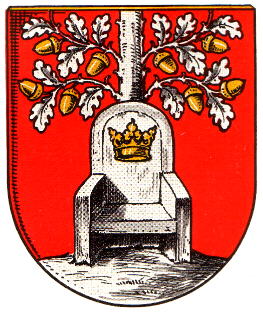Eime: Difference between revisions
Jump to navigation
Jump to search
Knorrepoes (talk | contribs) No edit summary |
Knorrepoes (talk | contribs) m (Text replace - "[[Literature" to "{{media}} [[Literature") |
||
| Line 22: | Line 22: | ||
The arms show the Royal Chair of Gudingen. This was place where in medieval times the German Kings, or their vassals, held a court of justice. This was always done under a huge oak tree. The arms symbolise the chair, the royal crown and the oak tree.<br/> | The arms show the Royal Chair of Gudingen. This was place where in medieval times the German Kings, or their vassals, held a court of justice. This was always done under a huge oak tree. The arms symbolise the chair, the royal crown and the oak tree.<br/> | ||
Historically, the city used seals with the patron saint, St. James. | Historically, the city used seals with the patron saint, St. James. | ||
{{media}} | |||
[[Literature]] : Stadler, K. : Deutsche Wappen - Bundesrepublik Deutschland. Angelsachsen Verlag, 1964-1971, 8 volumes. | [[Literature]] : Stadler, K. : Deutsche Wappen - Bundesrepublik Deutschland. Angelsachsen Verlag, 1964-1971, 8 volumes. | ||
Revision as of 21:07, 8 July 2014
| Heraldry of the World Civic heraldry of Germany - Deutsche Wappen (Gemeindewappen/Kreiswappen) |
EIME
State : Niedersachsen
District (Kreis) : Hildesheim (until 1978 Alfeld)
Additions : 1974 Deilmissen,Deinsen, Dunsen, Heinsen
Official blazon
Origin/meaning
The arms were granted on April 11, 1939.
The arms show the Royal Chair of Gudingen. This was place where in medieval times the German Kings, or their vassals, held a court of justice. This was always done under a huge oak tree. The arms symbolise the chair, the royal crown and the oak tree.
Historically, the city used seals with the patron saint, St. James.
Contact and Support
Partners:
Your logo here ?
Contact us
© since 1995, Heraldry of the World, Ralf Hartemink 
Index of the site
Literature : Stadler, K. : Deutsche Wappen - Bundesrepublik Deutschland. Angelsachsen Verlag, 1964-1971, 8 volumes.











